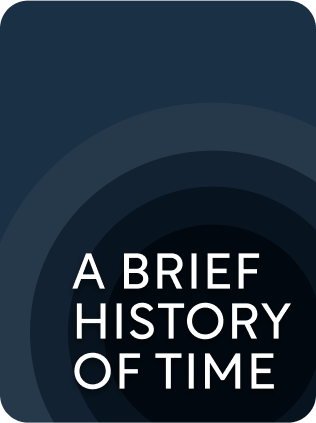

This article is an excerpt from the Shortform book guide to "A Brief History of Time" by Stephen Hawking. Shortform has the world's best summaries and analyses of books you should be reading.
Like this article? Sign up for a free trial here .
Is A Brief History of Time worth reading? Are its concepts easy enough to grasp?
A Brief History of Time is Stephen Hawking’s exposition of modern physics. The book answers questions about the nature of reality, predetermination of the future, the universe’s origins, black holes, and time travel. Hawking strives to make the answers to these big questions accessible to a general audience.
Keep reading for our A Brief History of Time review.
A Brief History of Time
Science has profound implications for philosophy and everyday life because science describes and predicts how the universe works. For example, the discovery that time itself had a finite beginning point implies that the physical universe is not eternal, and allows us to infer certain things about its origins.
To make the discoveries and implications of modern science more accessible to everyone, renowned physicist Stephen Hawking described the principles of modern physics for a general audience in A Brief History of Time.
Our A Brief History of Time review takes a brief look at the book’s author, publication, context, strengths and weaknesses, organization, and approach.
About the Author
Stephen Hawking first became famous in the physics community for his study of “singularities” (a concept we explain in our guide) in the 1960s, along with George Ellis and Roger Penrose. One of their notable conclusions was that time itself began at a finite point. In 1974, at age 32, he became the youngest scientist ever elected as a Fellow of the Royal Society. He continued to make contributions to the advancement of theoretical physics throughout his life.
However, Hawking’s popularity outside the close-knit community of theoretical physicists was due as much to human factors as scientific brilliance. At age 21, he was diagnosed with ALS, a medical condition that causes motor neurons to degenerate, resulting in loss of motor functions throughout the body. Initially, doctors estimated that he had just a few years to live. Yet, despite using a wheelchair and losing the ability to speak, Hawking remained active in his field. He passed away in 2018, 55 years after his diagnosis.
The combination of his perseverance in the face of disability, his scientific prowess, and his willingness to explain arcane scientific concepts for a general audience propelled him to celebrity status by the late 1980s.
As one of the people who discovered the beginning of time, Hawking is particularly qualified to discuss its origins and history, as he does in A Brief History of Time.
The Book’s Publication
A Brief History of Time was published in 1988 by Bantam Books, an imprint of Random House Publishing. It was Hawking’s first book for a popular audience. It set new records as a best-seller, appearing in the New York Times bestseller list for 147 weeks and in the Times of London list for 237 weeks. To date, it has sold over 25 million copies. Hawking went on to publish a number of other popular books, including The Universe in a Nutshell and Brief Answers to the Big Questions, but A Brief History of Time remains his most popular book.
The Book’s Historical and Intellectual Context
In the twentieth century, new scientific theories changed the way scientists viewed the world. Einstein’s theory of relativity replaced Newton’s laws as a model of gravity for predicting the motion of celestial bodies, and the discovery of quantum mechanics created a new way of modeling the microscopic particles that make up matter and energy. Hawking and his contemporaries built upon these new theories and explored their implications.
In Hawking’s view, philosophers of the twentieth century were unable to keep up with the latest scientific discoveries, even though some of these discoveries had important philosophical implications.
Against this backdrop, Hawking wrote A Brief History of Time to help people outside the physics community understand modern physics, as well as its philosophical implications.
The Book’s Strengths and Weaknesses
Book reviewers unanimously agree that Hawking is a genius when it comes to physics, but they are divided on the question of how well he explains physics to a general audience. Some people find the book an easy and engaging read, while others struggle to understand it.
Critics point out that Hawking sometimes presents conclusions without explaining his reasoning. However, they concede that this was likely because his reasoning was too mathematically involved for a general audience to understand.
The Book’s Organization and Approach
Hawking’s approach roughly parallels the order in which these topics would be covered in a college physics program, albeit at a less technical level.
Specifically, the book presents a survey of principles from modern physics, loosely following the order in which they were discovered. It begins with a summary of relevant concepts from classical physics, then goes on to discuss relativity and quantum mechanics, and finally considers some of the more nuanced implications of the new theories, such as the nature of black holes and the possibility of time travel.
In cases where Hawking was personally involved in the scientific investigations, he recounts anecdotes about the circumstances of the discovery. Throughout the book, he also discusses the broader implications of scientific discoveries for philosophy and life.
Our Approach in Our Guide
In our guide, we’ve rearranged the discussion around a series of questions that the book addresses. We consider each question in turn, presenting the conclusion up front and then digging into the details and reasons behind it, instead of gradually building up to a conclusion from the details, as the book does.
We also cross-reference the book with other sources, especially in cases where additional scientific data that was collected after the book’s publication may affect Hawking’s conclusions.

———End of Preview———
Like what you just read? Read the rest of the world's best book summary and analysis of Stephen Hawking's "A Brief History of Time" at Shortform .
Here's what you'll find in our full A Brief History of Time summary :
- The search for a theory that explains the history and evolution of our universe
- Stephen Hawking's discussions about time, space, dimensions, and quantum theory
- How time travel would theoretically work






